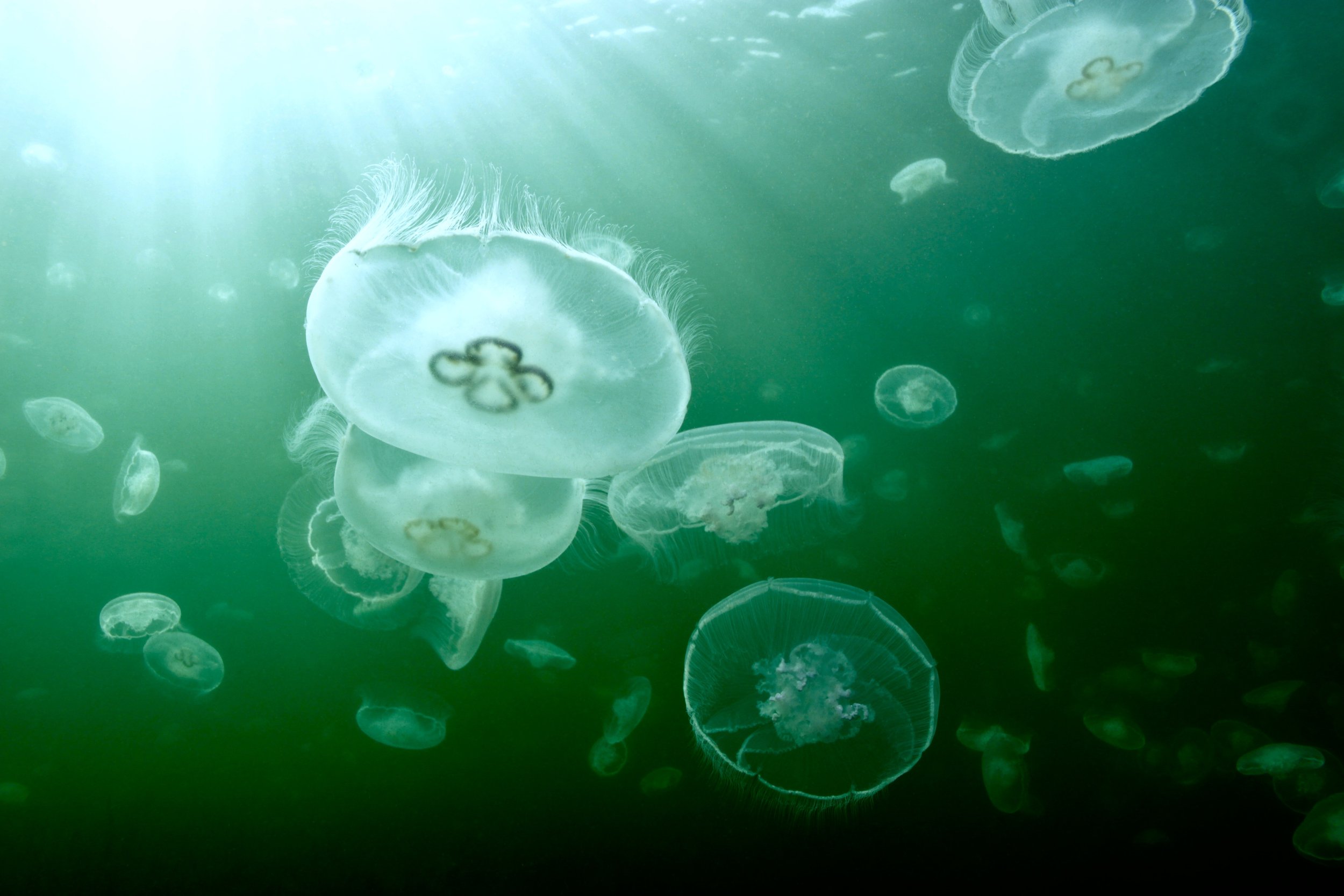Moon Jelly
Aurelia labiata
Despite their lack of eyes, smile, or central nervous system, the Moon jelly has excelled at capturing the attention and hearts of millions around the world. Those of us who live near the coastline are extremely lucky to be able to view and appreciate these wonders as often as we are able to; especially in British Columbia, where Moon jellies can sometimes be seen in the thousands, feeding on the rich plankton that blooms in our many fjords and inlets.
Jellies are often hailed as one of the most bizarre groups of sea creatures on earth, with very good reason. Their otherworldliness isn’t only surface level; their life-history, anatomy, and behaviours are at least as equally as bizarre.
This artwork is inspired by my photograph of the Moon jelly below:
October 2017: A particularly large Moon jelly grazing on the last remnants of a recent plankton bloom in the Saanich Inlet. Photographed in Brentwood Bay, B.C.
📖 Description 📖
Moon jellies are encountered in virtually all coastal ecosystems, save for the Southern Ocean. Within the ecosystems they have been observed, they are the most common and successful in temperate oceans, including the Northeast Pacific. As many as 25 different species of Moon jelly have been described. In British Columbia, we are lucky to have local populations of the very large Aurelia labiata Moon jelly, which can grow up to 45 centimeters in diameter.
At the centre of the jellyfishes bell lie the titular crescent-shaped organs we have come to know and love. These are the reproductive organs (gonads) where male and female jellyfish produce eggs and sperm. On rare occasions, a moon jelly may have as many as 6 or 7 gonads! For marine enthusiasts, such an encounter is not unlike finding a 4-leaf clover.
Upon close inspection, Moon jellies feature fascinating organs known as rhopalia. These organs help the jelly understand which direction is up and down, and also detect light. In this sense, jellyfish can “see”, despite the absence of a brain [1]!
January 2020: On larger jellies, the Rhopalia can be easily seen lining the margins of the jelly’s bell. Some jellies, including Aurelia labiata, can have as many as 16 different rhopalia! Photographed in Willis Pt, B.C.
🌎 Distribution 🌎
While Moon jellies as a genus have a near-cosmopolitan distribution, Aurelia labiata is largely restricted to the waters between the Gulf of Alaska and Central California. Interestingly, the species has three distinct morphotypes (body forms) unique to various regions up and down the Pacific Coastline. This species of moon jelly grows to be the largest in the waters around Central California [2]. Some rare sightings of Aurelia labiata have been reported from the waters of Korea and the Philippines [3].
Distribution of the Moon jelly, Aurelia labiata. Suitable habitat depicted in red.
🏝 Habitat 🏝
While Moon jellies are capable of swimming on their own, they do not have the strength to swim against currents, especially those that are encountered within the confines of the Salish Sea, where in some regions, currents can reach up to 12 knots (24 kilometres an hour)!
As a result, Moon jellies are much more common in areas that see little to no water movement, such as coastal fjords, inlets, harbours, and bays. In these areas, Moon jellies can readily reproduce and multiply at astonishing rates, leading to jelly blooms. At times, there can be so many jellies that it can be difficult for scuba divers to swim through the water without risking injury to the jellies.
While Moon jellies rely on smaller plankton as a food source, they have been encountered as deep as 1 kilometre beneath the surface!
Depth of suitable habitat for the Moon jelly, Aurelia labiata. Suitable habitat depicted in red. Not to scale.
🌊 Diet 🌊
While many ocean-goers are wary of jellies for their painful sting, the Moon jellies have much shorter and weaker tentacles that are only capable of capturing small organisms such as planktonic diatoms, copepods, and larval fishes. To humans, Moon jellies are in no way harmful to the touch, however that does not mean that our touch isn’t harmful to them! Jellies are extremely delicate; handling them and taking them out of the water can seriously injure them!
October 2017: A ‘smack’ of Moon jellies taking advantage of a bright autumn morning to feed on phytoplankton growing in the sunlight. The density of jellies in this picture pales in comparison to the thickness of some moon jelly blooms recorded in nearby areas. Photographed in Brentwood Bay, B.C.
🪼 Life Cycle 🪼
The life-history of the Moon jelly (and all jellies for that matter) is particularly bizarre. The charismatic, bell-shaped creatures we recognize as a jelly is only half of the full story. When a Moon jelly egg is fertilized, it does not develop into another jelly. Instead, it settles to the sea floor and develops into something resembling more of a sea anemone than a jelly, known as a polyp. This polyp undergoes an otherworldly process known as strobilation, where the polyp morphs into what is essentially a stack of upside down, baby jellyfish. One by one, these male and female baby jellyfish pop off and swim off into the sea to begin their lives.
Some jellyfish polyps can last several years, and will continually give ‘birth’ to many baby jellies over the course of their lifespan.
October 2017: An adult Moon jelly as seen from below, featuring its frilly stomach. Aurelia labiata is identified by the number of indentations along the edge of the jelly. This species most often has 16.
📚 References 📚
[1] Budelmann, B. (1988). Morphological diversity of equilibrium receptor systems in aquatic invertebrates. In J. Attema, (ed.), Sensory Biology of Aquatic Animals. Springer-Verlag, N.Y. 757–782. https://doi.org/10.1007/978-1-4612-3714-3_30
[2] Animal Diversity Web. (2005). Aurelia labiata. https://animaldiversity.org/accounts/Aurelia_labiata/
[3] World Register of Marine Species. (n.d.). Aurelia labiata (Chamisso & Eysenhardt, 1821). Retrieved July 10, 2022, from https://www.marinespecies.org/aphia.php?p=taxdetails&id=287213#distributions






